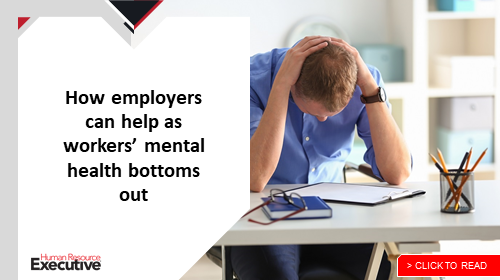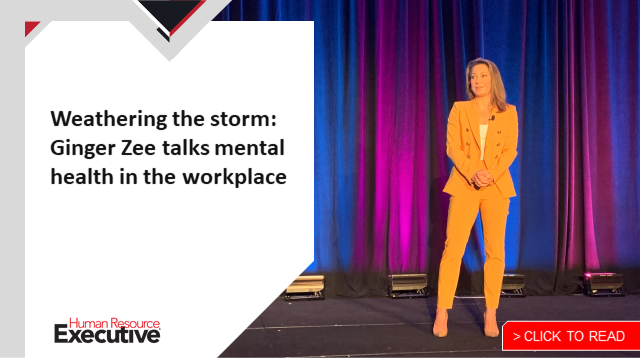Back in 2020, at the onset of the pandemic, employers turned to mental health help as employees reeled from isolation, uncertainty and new levels of stress. Many companies expanded employee assistance programs, held worker listening sessions, ensured employees had telehealth options for mental health services, added mental health apps and point solutions—like Headspace or Calm—and more.
Two-plus years later, a heightened focus on mental health isn’t going away: Rates of employee stress, burnout, depression, anxiety and post-traumatic stress disorder are still up considerably. And after implementing more benefits, many employers are trying to figure out what’s working, what’s not and what’s the best way forward with their mental health efforts.
“Everyone is keenly aware, especially after what’s happened over the past two years, that they can’t ignore mental health, either from a general wellbeing side or from a clinical perspective,” says Jennifer Jones, population health practice leader at Springbuk, a health data analytics firm. “[Employers] are all very hungry to understand how they can best put the right programs in place to be able to have a positive impact with their members and ensure that they’re really taking care of them. That’s everything from anxiety, to depression, to general financial wellness, and just overall mental wellbeing.”
So what should HR and benefits leaders consider when they evaluate their mental health offerings? How can they best give workers what they need? And how does the hot job market come into play? Here’s what Jones advised in a recent conversation with HRE.
HRE: What should employers know about evaluating their mental health benefits?

Jones: One of the biggest takeaways is how critical it is to be able to use their data to analyze their specific population. And that, essentially, will ensure that they’re adding the right mix of those types of programs to really help address their needs—and not continue to add to a lot of additional healthcare spending. Where we see people really finding impact and having positive outcomes is really a mix. It’s a mix of making sure the actual benefit plan is covering in-person visits, but also adding on different point solutions as far as telemedicine visits, or features like Headspace where they can connect to generally work on their wellbeing. It’s also a matter of understanding what their employees want. Traditionally, we’ll encourage [employers] to survey and ask workers what they want to see. What’s most important to them that they would ultimately engage with? In that way, you’re not necessarily just throwing out a bunch of solutions and hoping they stick essentially, but you’re really getting the best feedback from your employees to know what types of programs be most beneficial for them.
HRE: When you talk about collecting data, is surveying employees the first step?
 Jones: Surveying would be in conjunction with actually using real claims experience—medical claims and pharmacy claims. Through that, [an employer] can understand from their health claim perspective more about the clinical understanding as far as the specific types of conditions—mental health and broad spectrum. So, is it anxiety? Is it depression, is it substance abuse, ADHD? Then being able to tailor the specific types of programs to what you see.
Jones: Surveying would be in conjunction with actually using real claims experience—medical claims and pharmacy claims. Through that, [an employer] can understand from their health claim perspective more about the clinical understanding as far as the specific types of conditions—mental health and broad spectrum. So, is it anxiety? Is it depression, is it substance abuse, ADHD? Then being able to tailor the specific types of programs to what you see.
The other piece of that is being able to look at it from a demographic standpoint. [For instance, our data] initially back in 2020 saw a tremendous rise in anxiety, particularly among females. In broader terms, females get seen 50% more often for mental health issues than men. Those are the other kind of data points that are really important to [think about]. So if an employer has a predominantly female population or workers in certain ages, that might influence certain programs.
HRE: Tell me about telemedicine and its role in mental health offerings.
Jones: Mental health services have actually eclipsed all other telehealth services. That is one silver lining—that we found this new mode of opportunity to help treat mental health through telemedicine. We continue to see this now two years out where people are still finding great opportunity to receive care, via Zoom or just not having to go in person.
And knowing that we have a shortage of mental health providers now and it often can take months sometimes to get into a provider, this provides a much faster opportunity to connect with an individual. So if you’re in more of an acute or crisis type of situation, that can be obviously extremely beneficial.
HRE: How can employers balance having enough options for employees and having too much, especially given the cost associated with having several options?
Jones: A lot of it goes back to surveying. It’s understanding what are employees’ preferred methods: What are they comfortable with? What types of offerings are they interested in? What do they need help with? Is it things for burnout or anxiety or even financial stress? You can really pinpoint the types of areas to address and then it comes down to being able to track those programs over time to understand general utilization.
HRE: What about ensuring employees know what’s offered?
Jones: Really over-communicating the benefits that exist is important. Maybe it’s monthly or quarterly. Maybe it’s when an employee has a major life event—someone gets married or has a kid. Or maybe it’s during universal times of crisis.
HRE: If I’m an employer rethinking my wellbeing programs and my mental health offerings specifically, especially as open enrollment is coming up, what would your advice be?
 Jones: The first step is to take stock of what you have in place and understand everything from what’s covered with the health plan to any added-on point solutions to anything that your wellness committee or anyone else is providing. Then really using the power of data, that ideally you should have access to, to be able to understand what are the conditions that are driving your mental health spend, as well as the makeup of your demographics. Use all that to really align: What do we have in place, and where do we have gaps? And in the gaps, where are there opportunities?
Jones: The first step is to take stock of what you have in place and understand everything from what’s covered with the health plan to any added-on point solutions to anything that your wellness committee or anyone else is providing. Then really using the power of data, that ideally you should have access to, to be able to understand what are the conditions that are driving your mental health spend, as well as the makeup of your demographics. Use all that to really align: What do we have in place, and where do we have gaps? And in the gaps, where are there opportunities?
HRE: We’re in an employee-driven job market right now. How does this come into play as employers think about their offerings?
Jones: Employers really added a lot of benefits in 2020, and now, we’re kind of at this tipping point as far as: Do we continue to add more or do we take away? What we have seen, though, is that the whole benefits package has really turned into this retention tool. It’s a challenging time right now to take away any benefits. Even for a program that may not necessarily have a lot of utilization, or utilization where you would expect it to be given the cost, it’s going to be really challenging to try to pull back anything back right now. I would sit tight on getting rid of any benefits right now.
The post Is it time for employers to reevaluate mental health benefits? appeared first on HR Executive.